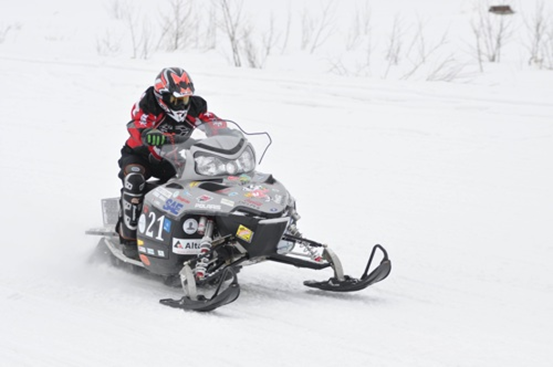| Engineering students win top honors for electric snowmobile |
Sandra Knisely 3/14/2011
There wasn’t much snow on the ground in Madison, Wisconsin, this weekend, but there was plenty in Houghton, Michigan, as a team of University of Wisconsin-Madison engineering students continued their tradition of dominance at the 2011 SAE Clean Snowmobile Challenge.
UW-Madison took second overall and first place in the zero-emissions category. This is the fourth consecutive year the team has won that category.
The Clean Snowmobile Challenge is a collegiate design competition sponsored by the Society of Automotive Engineers, held March 7-12 at Michigan Technological University. Engineering students from participating schools reengineer stock snowmobiles to reduce emissions and noise while maintaining or boosting performance.
Advised by Mechanical Engineering Faculty Associate Glenn Bower, the UW-Madison team entered an internal combustion sled along with the victorious electric sled in the competition this year.
The ultimate goal of the zero-emissions competition is to develop sleds that will allow scientists at the North and South Poles to travel between research stations without emitting any emissions, which can skew data results.
One of the competition challenges tests how far each electric sled can go on a single charge. The UW-Madison team traveled 20.8 miles—well beyond the 12 miles achieved by the next closest sled.
Team captain Shawn Spannbauer was pleased at the competition results. “We did great all week. Everything went well,” he says. “This is a young team. It was a lot of fun.”
The team earned several competition awards, including the Society of Automotive Engineers Award for best design, the AVL Award for Best Emissions, Sensors Inc. Award for Lowest “In Service” Emissions, KRC Award for Draw Bar Pull, and CH2M Hill Polar Services Range Event Award.
Clarkson University took the top overall prize, with the University of Idaho, State University of New York at Buffalo and the University of Wisconsin-Platteville rounding out the top five.

The UW-Madison zero-emissions sled at the 2011 SAE Clean Snowmobile Challenge. Photo by John Hatch.
| 2011 Clean Snowmobile Challenge the Biggest and Greenest Yet |
2/28/2011
Source: Michigan Technological University
Newswise — A record number of electric snowmobiles have registered for the 2011 SAE Clean Snowmobile Challenge, set for March 7-12 at Michigan Technological University’s Keweenaw Research Center. This year, they will be greener than ever.
The Clean Snowmobile Challenge is a collegiate design competition of the Society of Automotive Engineers. In the internal combustion category, engineering students from participating schools take a stock snowmobile and reengineer it. Their aim: to reduce emissions and noise while maintaining or boosting performance.
The zero-emissions category, for battery-powered sleds, is sponsored by the National Science Foundation, which uses electric snowmobiles while conducting research in pristine arctic locations.
Thirteen teams are participating in the internal-combustion division, with seven entered in the zero-emissions category, the most since the division was added in 2006. The total number of entries—20—is the highest in Challenge history.
While electric snowmobiles themselves may have no emissions, their batteries must be charged with electricity. In the past, much of that electrical power has been generated by coal-fired plants, which emit carbon dioxide into the atmosphere.
But last year, Challenge organizers took a step to mitigate those greenhouse gas emissions.
“We put a solar panel out back of the Keweenaw Research Center,” said Jay Meldrum, the Challenge’s co-director. “In a year’s time, one solar panel lets us bank enough energy to charge all the zero emissions sleds. We have already made eight kilowatt hours of energy, and we’re going to make a lot more.”
That means that by the time the student engineers arrive in March, the solar panel will have generated at least as much electricity as the electric snowmobiles will use during the competition.
“This year, they will really be green,” Meldrum said. In addition, the Keweenaw Research Center will be installing more solar panels over the coming months.
Throughout the week, the internal combustion sleds are tested for noise, emissions and fuel economy, while the zero emissions snowmobiles are rated by how far they can travel on a single charge and how much they can pull. The internal-combustion machines will be engineered to run on flex fuel with a wide range of ethanol content. Competitors won't be told what fuel they are using until after the Challenge.
The public is welcome to Grand Opening ceremonies on Tuesday, March 8, which culminate in the Endurance Run north to Copper Harbor. The public is also invited to the acceleration and handling events, on Saturday, March 12. Winners are announced at the awards banquet later that evening.
Participating schools include Clarkson University of Potsdam, N.Y., Michigan Tech, North Dakota State University, the University of Alaska–Fairbanks, and the University of Wisconsin–Madison, which are each fielding an internal combustion and a zero emissions sled; Ecole De Technologie Superieure of Montreal, Kettering University of Flint, Northern Illinois University, State University of New York at Buffalo, the University of Idaho, the University of Maine, the University of Waterloo (Ont.), and the University of Wisconsin–Platteville, internal combustion; and McGill University of Montreal and the South Dakota School of Mines and Technology, zero emissions.
The Keweenaw Research Center and the Department of Mechanical Engineering-Engineering Mechanics are cosponsors of the SAE Clean Snowmobile Challenge.
For more information, visit www.mtu.edu/snowmobile.
|

